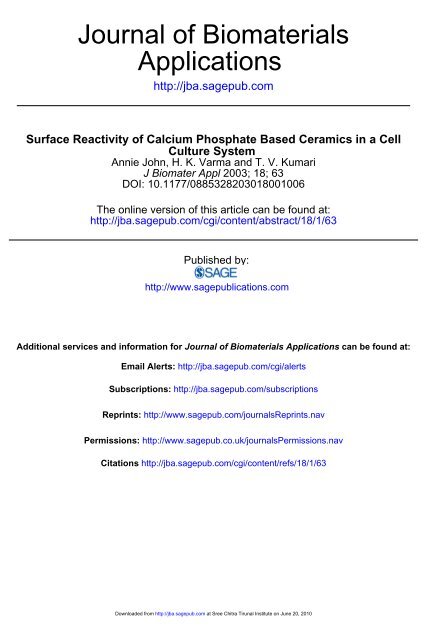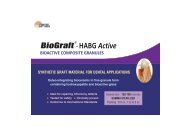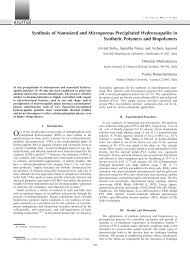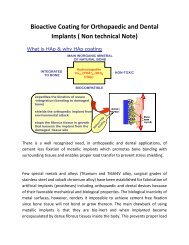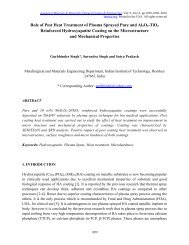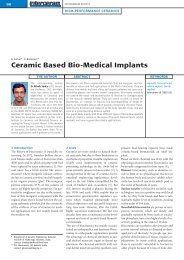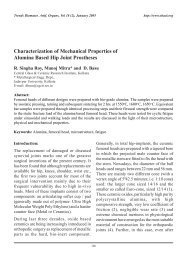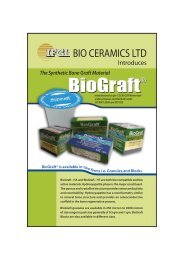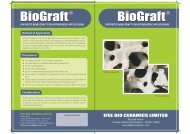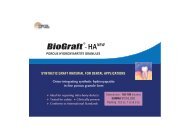Applications Journal of Biomaterials - IFGL Bio Ceramics Limited
Applications Journal of Biomaterials - IFGL Bio Ceramics Limited
Applications Journal of Biomaterials - IFGL Bio Ceramics Limited
Create successful ePaper yourself
Turn your PDF publications into a flip-book with our unique Google optimized e-Paper software.
<strong>Journal</strong> <strong>of</strong> <strong><strong>Bio</strong>materials</strong><br />
<strong>Applications</strong><br />
http://jba.sagepub.com<br />
Surface Reactivity <strong>of</strong> Calcium Phosphate Based <strong>Ceramics</strong> in a Cell<br />
Culture System<br />
Annie John, H. K. Varma and T. V. Kumari<br />
J <strong>Bio</strong>mater Appl 2003; 18; 63<br />
DOI: 10.1177/0885328203018001006<br />
The online version <strong>of</strong> this article can be found at:<br />
http://jba.sagepub.com/cgi/content/abstract/18/1/63<br />
Published by:<br />
http://www.sagepublications.com<br />
Additional services and information for <strong>Journal</strong> <strong>of</strong> <strong><strong>Bio</strong>materials</strong> <strong>Applications</strong> can be found at:<br />
Email Alerts: http://jba.sagepub.com/cgi/alerts<br />
Subscriptions: http://jba.sagepub.com/subscriptions<br />
Reprints: http://www.sagepub.com/journalsReprints.nav<br />
Permissions: http://www.sagepub.co.uk/journalsPermissions.nav<br />
Citations http://jba.sagepub.com/cgi/content/refs/18/1/63<br />
Downloaded from http://jba.sagepub.com at Sree Chitra Tirunal Institute on June 20, 2010
Surface Reactivity <strong>of</strong> Calcium<br />
Phosphate Based <strong>Ceramics</strong> in a<br />
Cell Culture System<br />
ANNIE JOHN,* H. K. VARMA AND T. V. KUMARI<br />
<strong>Bio</strong>medical Technology Wing<br />
Sree Chitra Tirunal Institute for Medical Sciences and Technology<br />
Poojapura, Thiruvananthapuram – 695 012, India<br />
ABSTRACT: Surface reactivity <strong>of</strong> CalciumPhosphate materials – Hydroxyapatite<br />
(HA), TricalciumPhosphate (-TCP), Hydroxyapatite-TricalciumPhosphate<br />
(HA-TCP) were elucidated in a cell culture system. MG-63 osteoblast-like<br />
cells were seeded onto the ceramic discs to evaluate changes in the cell<br />
morphology and functionality with respect to the different substrates.<br />
The dissolution and re-precipitation <strong>of</strong> calciumphosphate phases on the<br />
surface <strong>of</strong> the discs in the culture medium was found to be prominent on -TCP<br />
when compared with HA. Low calcium (Ca), magnesium (Mg) and alkaline<br />
phosphatase (ALP) levels and high phosphorous (P) levels in the medium <strong>of</strong><br />
-TCP were observed. This indicated that P must have leached out into the<br />
medium from -TCP and Ca in turn deposited fromthe mediumonto -TCP<br />
resulting in the apatite phase transformation. The low ALP activity in -TCP<br />
medium is however an indication <strong>of</strong> low osteoblastic activity.<br />
Under the phase contrast microscope, the osteoblast cells around HA material<br />
were found to be confluent and viable, while in the vicinity <strong>of</strong> -TCP only cellular<br />
debris was observed. In the case <strong>of</strong> HA-TCP, only a few viable cells surrounded<br />
the material amidst the debris. Scanning electron microscopy revealed<br />
numerous cells on the surface <strong>of</strong> HA showing different cell behaviour like<br />
anchorage, attachment, adhesion and spreading in the early time period as<br />
the surface was only slightly disturbed with re-crystallisation. But with time the<br />
entire surface <strong>of</strong> HA had changed due to precipitation and re-crystallization<br />
which did not support cell behaviour while the cells surrounding the material<br />
showed normal growth. On the contrary, cells were scarcely observed on the<br />
entirely changed surface <strong>of</strong> -TCP and HA-TCP even fromthe earlier days <strong>of</strong> the<br />
*Author to whom correspondence should be addressed. E-mail: ajkari@sctimst.ker.nic.in<br />
JOURNAL OF BIOMATERIALS APPLICATIONS Volume 18 — July 2003 63<br />
0885-3282/03/01 0063–16 $10.00/0 DOI: 10.1177/088532803032826<br />
ß 2003 Sage Publications<br />
Downloaded from http://jba.sagepub.com at Sree Chitra Tirunal Institute on June 20, 2010
64 A. JOHN ET AL.<br />
culture and the morphology <strong>of</strong> cells surrounding the material too started<br />
changing.<br />
These results establish that HA promoted the activity <strong>of</strong> osteoblast cells. HA<br />
surface remained unaltered for some time, while the surface <strong>of</strong> -TCP<br />
underwent dissolution <strong>of</strong> surface ions and resulted in the re-crystallization<br />
<strong>of</strong> apatite over the surface. The resulting changes in the surrounding milieu <strong>of</strong><br />
-TCP with high phosphate and low Ca levels probably was responsible for the<br />
death <strong>of</strong> the cells.<br />
KEY WORDS: in vitro, HA, -TCP, HA-TCP, dissolution, re-crystallization,<br />
osteoblast cells.<br />
INTRODUCTION<br />
Calcium phosphate based hydroxyapatite (HA) and Tricalcium<br />
Phosphate (-TCP) are major components <strong>of</strong> materials used as<br />
bone substitutes for almost the past three decades. The differences in<br />
the chemistry [1,2], the crystallographic structure [3], and the porosity<br />
[4,5], possibly govern the bioactivity <strong>of</strong> the materials, which in turn<br />
favoured the formation <strong>of</strong> new bone [6].<br />
Cell culture models are extensively investigated in the elucidation<br />
<strong>of</strong> cellular attachment and adhesion to Calcium Phosphate materials<br />
[7–12] for orthopaedic and dental applications. The cell density, the cell<br />
morphology and the viability differ according to the surface reactivity<br />
and physico-chemical nature <strong>of</strong> the substrate. Knowledge <strong>of</strong> the<br />
behaviour (anchorage, attachment. adhesion, spreading) and growth<br />
<strong>of</strong> specific bone forming cells on a material in a well controlled<br />
environment as in cell culture could help in predicting in vivo cell<br />
behaviour. The formation and deposition <strong>of</strong> bone directly onto the<br />
implant requires a surface that is not only non-toxic but also one that<br />
promotes the activity <strong>of</strong> osteoblasts. In short, the adhesion and growth<br />
<strong>of</strong> cells on ceramics are considered to be regulated by the time dependant<br />
variation <strong>of</strong> the surface structure.<br />
Here, we have adopted a cell culture model to study the surface<br />
behaviour <strong>of</strong> the in-house synthesized ceramic discs seeded with MG-63<br />
osteoblast-like cells under physiological conditions and to evaluate their<br />
morphology and functionality.<br />
Materials<br />
MATERIALS ANDMETHODS<br />
The materials used were in-house synthesized sintered disc<br />
shaped calciumphosphate based ceramics – viz HA, -TCP and a<br />
Downloaded from http://jba.sagepub.com at Sree Chitra Tirunal Institute on June 20, 2010
composite <strong>of</strong> HA and -TricalciumPhosphate (HA-TCP) seeded with<br />
osteoblast-like cells (MG-63).<br />
Preparation <strong>of</strong> Materials<br />
Hydroxyapatite and -TCP were prepared by the wet chemical<br />
method followed by the freeze drying technique [13] starting from<br />
calcium nitrate and ammonium dihydrogen phosphate solution. The<br />
powder was pressed in the form <strong>of</strong> a 12 mm diameter and 1.5 mm thick<br />
disc and sintered at 1200 C for 2 h. The sintered density for HA was<br />
approximately 98%, while the -TCP was only 70% dense. The phase<br />
analysis was carried out by XRD and the Ca/P ratio was determined by<br />
chemical analysis (data not shown). The HA-TCP composite was<br />
prepared by mixing equal weights <strong>of</strong> HA and -TCP and pressed as<br />
in the case <strong>of</strong> HA and -TCP samples. The sintering temperature<br />
was 1200 C for 2 h. All materials were cleaned with soap solution and<br />
acetone in an ultrasonicator, air dried and steamsterilised.<br />
Cell-culture<br />
Reactivity <strong>of</strong> <strong>Ceramics</strong> in Cell Culture 65<br />
MG-63 osteoblast-like cells (supplied by National Centre for Cell<br />
Sciences – NCCS, Pune, India is a well characterised cell line, originally<br />
isolated fromosteosarcoma) were used for these experiments.<br />
The cells (plating density <strong>of</strong> 1 10 3 cells/cm 2 ) were seeded onto HA,<br />
-TCP and HA-TCP discs which were placed in 24-well tissue culture<br />
plates (Nunc, USA) in Minimum Essential Media (Hi-Media, India)<br />
containing 10 % heat inactivated calf serumand 1 % pencillin-streptomycin.<br />
Culture was maintained in 5 % CO 2 atmosphere at 37 C and<br />
100 % humidity for 144 h, without any change <strong>of</strong> media. The experiment<br />
was stopped at 144 h, since it was observed that the cell growth would be<br />
affected, if fresh nutrients are not supplied further.<br />
As control – (1) HA and -TCP discs were placed in cell free medium<br />
for 2 h only to detect the changes, if any, on the surface <strong>of</strong> the discs<br />
and (2) cells alone in the medium was maintained for 144 h for<br />
biochemical analysis.<br />
Cell Morphology<br />
To evaluate changes in cell morphology, with respect to different<br />
substrates, cells around the material were examined by Phase Contrast<br />
Microscopy (Leica, MPS-32-PCM) and (2) cells on materials were<br />
evaluated by Scanning Electron Microscope (SEM). For SEM, the<br />
samples were rinsed three times in phosphate buffered saline (PBS) and<br />
fixed in 3 % glutaraldehyde and post-fixed in 1 % osmium tetroxide in<br />
Downloaded from http://jba.sagepub.com at Sree Chitra Tirunal Institute on June 20, 2010
66 A. JOHN ET AL.<br />
phosphate buffer. Thereafter, the discs were rinsed with phosphate<br />
buffer, sequentially dehydrated in 50, 70, 90 and 100 % methanol and<br />
dried in a Critical Point Dryer (Hitachi- HCP-2). A thin layer <strong>of</strong> gold was<br />
sputter coated onto samples prior to examination in SEM (Hitachi-<br />
S2400).<br />
<strong>Bio</strong>chemical Analysis<br />
The media alone were removed from the test and control wells<br />
(triplicates) after 144 h <strong>of</strong> incubation and stored in aliquots at 4 C for<br />
biochemical analysis. The media were tested for Calcium (Ca) and<br />
Magnesium(Mg) concentration using atomic absorption spectrophotometry<br />
(Hitachi-220). Phosphorous (P) concentration was measured<br />
spectrophotometrically using the Modified Method Kit for Phosphorous<br />
(Qualigens-Glaxo) and absorbance was measured at 680 nm and<br />
expressed as ppm(parts per million). Alkaline Phosphatase activity<br />
was determined using a kit based on Kind and Kings’ method<br />
(Qualigens-Glaxo) and absorbance was measured at 510 nm and<br />
expressed as KAU (King AngstromUnit).<br />
Morphological Evaluation<br />
RESULTS<br />
Phase Contrast Microscopic Evaluation<br />
Morphologically the osteoblast-like cells around HA discs were spindle<br />
shaped and showed no toxicity by 144 h and the cells around HA<br />
materials were observed to be <strong>of</strong> the same morphology as cells alone<br />
(Figure 1A). But cells in the vicinity <strong>of</strong> -TCP were gradually showing<br />
changed morphology and finally by 144 h cell degeneration was observed<br />
(Figure 1B). In the case <strong>of</strong> HA-TCP, only a few cells in the medium<br />
showed normal morphology similar to cells alone, while the rest were<br />
degenerated in the culture by 144 h (Figure 1C).<br />
Scanning Electron Microscope Evaluation<br />
(a) HA Sample<br />
Isolated areas over the surface <strong>of</strong> the dense HA material underwent<br />
gradual microstructural changes in the medium alone by 24 h<br />
(Figure 2A). In areas where there were no surface changes, normal<br />
adhesion, spreading and proliferation were noted (Figure 2B). But in<br />
the cell culture medium prolonged for 144 h the entire surface<br />
re-precipitated. So intact grains and grain boundaries in these areas<br />
were disrupted completely exhibiting blanket coverage <strong>of</strong> precipitates <strong>of</strong><br />
Downloaded from http://jba.sagepub.com at Sree Chitra Tirunal Institute on June 20, 2010
Reactivity <strong>of</strong> <strong>Ceramics</strong> in Cell Culture 67<br />
Figure 1. Phase Contrast Micrographs <strong>of</strong> MG-63 osteoblast-like cells in the culture<br />
medium surrounding – (A) HA as normal cells; (B) -TCP as degenerated cells and (C) HA-<br />
TCP as normal cells with degenerated cells . Magnification 300.<br />
Figure 2. Scanning Electron Micrographs <strong>of</strong> the surface topography <strong>of</strong> HA disc – (A) in<br />
the cell free culture medium for 24 h, showing patches <strong>of</strong> slightly disrupted areas; (B) in the<br />
cell (MG-63) culture medium for 24 h with adhered cells and (C) in the cell (MG-63) culture<br />
medium for 144 h showing the re-precipitated surface, magnified as calcium phosphate<br />
plate-like crystals with hardly any normal cells.<br />
Downloaded from http://jba.sagepub.com at Sree Chitra Tirunal Institute on June 20, 2010
68 A. JOHN ET AL.<br />
calciumphosphate plate-like crystals (Figure 2C), which did not support<br />
any cell attachment due to the changed topography <strong>of</strong> HA.<br />
(b) -TCP<br />
In the case <strong>of</strong> -TCP, the microstructure is different from HA as the<br />
density was lower. Here, the surface was affected to a greater extent in<br />
the medium when compared to HA. The creation <strong>of</strong> new needle-like<br />
crystallites fromin between the pores <strong>of</strong> the grains <strong>of</strong> -TCP exhibited a<br />
flower-like pattern on the sample surface (Figure 3A, B). The new phase<br />
may be due to the re-crystallised apatite and very scarce cells were<br />
found adhered on the surface. The attached cell failed to spread on the<br />
re-crystallised topography <strong>of</strong> -TCP (Figure 3C, D).<br />
(c) HA-TCP<br />
The re-crystallised surface topography <strong>of</strong> HA-TCP in the medium was<br />
intermediate between that seen on HA and -TCP. The portion <strong>of</strong> the<br />
cells on re-crystallised free areas <strong>of</strong> HA-TCP adhered and spread flat<br />
Figure 3. Scanning Electron Micrographs <strong>of</strong> the surface topography <strong>of</strong> -TCP disc in the<br />
culture medium – (A) alone without cells for 24 h, showing the shaken grain arrangement<br />
and (B) with MG-63 cells for 24 h, exhibiting a cell spotted amidst the needle-like<br />
crystallites in between the shaken grains; (C) for 144 h showing a magnified image <strong>of</strong> the<br />
new topography with sprouts <strong>of</strong> needle-like crystallites and (D) with a magnified image <strong>of</strong> a<br />
cell lying embedded in between the sprouts <strong>of</strong> needle-like crystallites.<br />
Downloaded from http://jba.sagepub.com at Sree Chitra Tirunal Institute on June 20, 2010
Reactivity <strong>of</strong> <strong>Ceramics</strong> in Cell Culture 69<br />
Figure 4. Scanning Electron Micrographs <strong>of</strong> the surface topography <strong>of</strong> hydroxyapatite-<br />
Tricalciumphosphate (HA-TCP) disc in the cell culture medium(A) after 24 h, showing a<br />
partially re-crystallised disturbed surface with cells adhered on the surface and (B) after<br />
144 h, showing a magnified image <strong>of</strong> the re-crystallised area <strong>of</strong> plate-like and needle-like<br />
crystallites.<br />
while those on the re-crystallised areas failed to spread out (Figure 4A).<br />
Grains and grain boundaries were clearly disrupted with re-crystallization<br />
areas <strong>of</strong> plate-like and needle-like intermediate crystallites <strong>of</strong><br />
different calciumphosphate phases (Figure 4B).<br />
(d) Cells Seeded on the Coverslip (Control)<br />
Confluent normal morphology <strong>of</strong> cells were observed on the coverslip<br />
until 144 h.<br />
<strong>Bio</strong>chemical Analysis<br />
The levels <strong>of</strong> P, Ca, and Mg in the medium <strong>of</strong> HA were comparable<br />
with control and ALP concentration indicated functional activity <strong>of</strong> the<br />
cells. Low Ca and Mg levels and high P concentrations in the medium<br />
surrounding -TCP, showed that Ca has been precipitated as apatite<br />
phase resulting in the phase transformation <strong>of</strong> the surface <strong>of</strong> -TCP.<br />
Low ALP concentration indicated less functional activity <strong>of</strong> the cells in<br />
the medium containing -TCP when compared with the other materials.<br />
Ca, P, Mg and ALP levels observed in the medium <strong>of</strong> HA-TCP<br />
were intermediate when compared with the media <strong>of</strong> HA and -TCP<br />
(Table 1).<br />
DISCUSSION<br />
Surface properties <strong>of</strong> biomaterials play a critical role in the establishment<br />
<strong>of</strong> cell–material interface. With respect to bioactive calcium<br />
phosphate ceramics, it is observed that the chemical composition,<br />
Downloaded from http://jba.sagepub.com at Sree Chitra Tirunal Institute on June 20, 2010
70 A. JOHN ET AL.<br />
Table 1. The biochemical analysis <strong>of</strong> Calcium (Ca), Phosphorous (P),<br />
Magnesiun (Mg) and Alkaline Phosphatase (ALP) in the cell culture medium<br />
<strong>of</strong> hydroxyapatite (HA), Tricalcium phosphate (-TCP) and HA-TCP composite,<br />
after 144 h <strong>of</strong> incubation.<br />
P (ppm) Ca (ppm) Mg (ppm) AIP (KAU)<br />
HAP and cells in medium 16.2 1.5 59.1 3.3 15.3 2.4 0.77 0.27<br />
-TCP and cells in medium 22.1 3.1 32.6 4.9 9.7 1.5 0.33 0.09<br />
HA-TCP and cells in medium 15 2.6 55.8 7.2 14.7 1.8 0.62 0.08<br />
Cells in the medium alone 17.5 2.0 60.9 6.4 14.2 25 0.64 0.10<br />
physical characteristics and crystal structure play an important role in<br />
the cell response [14,15]. In vitro cytocompatibility studies are<br />
increasingly concerned with the influence <strong>of</strong> surface topography, surface<br />
change and consecutive adsorption <strong>of</strong> proteins on cell attachment and its<br />
proliferation [16]. In this study, we have investigated the morphological<br />
and functional response <strong>of</strong> osteoblast-like cells to HA, -TCP and a<br />
composition <strong>of</strong> HA-TCP mixture in the disc form. Calcium Phosphate<br />
ceramics with Ca/P ratios <strong>of</strong> either 1.67 or 1.5 have been reported to be<br />
biocompatible [1,17]. However, the factors concerning the bioresorption/<br />
biodegradation <strong>of</strong> calcium phosphate ceramics have not been completely<br />
elucidated [18].<br />
Dense HA (Ca/P 1.67) being a bioactive ceramic, the solubility product<br />
is low, implying a low rate <strong>of</strong> dissolution. So there was only a gradual<br />
microstructural change <strong>of</strong> the HA surface by 24 h in the medium alone<br />
(Figure 2A). A favourable surface for cell attachment, adhesion and<br />
spreading (Figure 2B) was evident by 24 h, promoting ALP activity and<br />
cell proliferation, thereby displaying the cytocompatibility <strong>of</strong> the ceramic<br />
to osteoblasts. On HA after 24 h in cell culture, flattened morphology <strong>of</strong><br />
osteoblast cells with extended long cytoplasmic processes over the<br />
surface and into micropores, were reported by Hing et al. [19] and cell<br />
proliferation is considered to be related to ALP activity [20]. High<br />
surface free energy and presence <strong>of</strong> hydroxyl groups on HA substrate<br />
has also promoted cell adhesion on its surface as described by others<br />
[21–23]. But by 144 h in the cell culture medium, the entire surface <strong>of</strong><br />
HA re-precipitated, which did not support cell attachment and adhesion<br />
(Figure 2C). The substances leached fromHA can cause dramatic<br />
changes in local pH which in turn affects protein adsorption on HA and<br />
this may affect subsequent cellular responses towards the material [24].<br />
Even though we did not find any cytotoxic response <strong>of</strong> osteoblasts on our<br />
HA discs, it is reported that fine particles <strong>of</strong> HA can cause cell damage<br />
in vitro. This toxicity evidenced by membrane damage is due to direct<br />
Downloaded from http://jba.sagepub.com at Sree Chitra Tirunal Institute on June 20, 2010
Reactivity <strong>of</strong> <strong>Ceramics</strong> in Cell Culture 71<br />
contact between cells and particles and is largely independent <strong>of</strong> the<br />
chemical nature <strong>of</strong> the particle [25]. However the cells around the<br />
material showed normal cell growth and proliferation (Figure 1A) where<br />
P, Ca, Mg levels were low with high ALP levels which indicated<br />
osteoblastic activity (Table 2). Costa and Fernandes [26] has reported a<br />
decrease in the levels <strong>of</strong> calciumand phosphorous with HA samples<br />
which represent the ongoing process in the mineralisation process –<br />
a calciumphosphate deposition in culture. Anselme et al. [27] related<br />
this modification <strong>of</strong> calcium and phosphorous concentration in cell<br />
culture medium to a dissolution phenomenon <strong>of</strong> materials as no such<br />
variation is seen in control wells. This fluctuating chemical (Ca, P, Mg,<br />
ALP) environment in the culture medium has in turn favoured the<br />
growth <strong>of</strong> the osteoblasts around the material for biomineralization. The<br />
extracellular pools <strong>of</strong> Ca, P, and Mg are in equilibriumwith much larger<br />
intracellular pools. The ion levels <strong>of</strong> the culture medium are adjusted in<br />
accordance with the solubility kinetics <strong>of</strong> different materials via removal<br />
<strong>of</strong> eluted ions by metabolism or circulatory processes. The role <strong>of</strong> ion<br />
levels in cell adhesion and cellular metabolic activity should be clarified,<br />
since particularly divalent cations including Mg 2þ , are known to be<br />
active in cell adhesion mechanisms [28,29]. So besides Ca and Phosphate<br />
contents, we have measured the concentration <strong>of</strong> Mg in the culture<br />
medium. ALP appears to play a crucial role in the initiation <strong>of</strong> matrix<br />
mineralisation providing localised enrichment <strong>of</strong> phosphorous and after<br />
that the expression <strong>of</strong> the enzyme is down regulated [30–32]. The<br />
surface roughness, porosity and particle size <strong>of</strong> biomaterials, indeed<br />
influence the activity <strong>of</strong> osteoblast cells [25,33,34] and the stability <strong>of</strong><br />
HA is less if the surrounding media is sufficiently acidic [35].<br />
Porous -TCP with a Ca/P ratio <strong>of</strong> 1.5 in porous formwas used in this<br />
study. It is an unstable ceramic where the solubility product is high,<br />
leading to high rate <strong>of</strong> dissolution. The higher porosity <strong>of</strong> -TCP<br />
enhances the rate <strong>of</strong> dissolution [36,37]. As -TCP dissolved, the<br />
solubility <strong>of</strong> -TCP surface approached the solubility <strong>of</strong> HA and<br />
decreased the pH <strong>of</strong> the solution which further increased the solubility<br />
<strong>of</strong> -TCP and enhanced the dissolution. The presence <strong>of</strong> micropores in<br />
the sintered material increased the surface area and ensured contact<br />
with the medium and increased the rate <strong>of</strong> dissolution. The above<br />
possibilities were confirmed by the surface morphology <strong>of</strong> -TCP as<br />
observed with SEM (Figure 3A–D) which showed that most <strong>of</strong> the<br />
surface <strong>of</strong> -TCP has undergone dissolution and re-precipitation,<br />
leading to needle-like apatite crystallites.<br />
The variation in solubility <strong>of</strong> calciumphosphates could in turn be<br />
a cause in changes <strong>of</strong> cell adhesion. This is because when the surface <strong>of</strong><br />
Downloaded from http://jba.sagepub.com at Sree Chitra Tirunal Institute on June 20, 2010
72 A. JOHN ET AL.<br />
-TCP changes, the altered surface characteristics <strong>of</strong> the material affect<br />
protein adsorption and subsequent protein mediated cell function<br />
[38–40]. Cells were scarcely distributed on the re-precipitated surface.<br />
This could be the reason why cell contact and adhesion was poor on<br />
-TCP, very apparent by the round appearance <strong>of</strong> the cell (Figure 3C, D)<br />
that failed to attach well and spread on the new surface.<br />
The change in morphology <strong>of</strong> osteoblast-like cells surrounding -TCP<br />
in the cell culture medium was evident by 96 h <strong>of</strong> incubation and by<br />
144 h resulted in death <strong>of</strong> the cells (Figure 1B). In cells, calciumions has<br />
the primary function <strong>of</strong> signal transduction and acts as a secondary<br />
messenger and phosphorous ions helps in energy production and supply<br />
to the cell while magnesium ions are known to inhibit the formation <strong>of</strong><br />
apatites and stabilise the structure <strong>of</strong> whitlockite. The dissolution/<br />
re-crystallisation at the ceramic surface and the exchange <strong>of</strong> ions<br />
between the cell culture medium resulted in high phosphorous and low<br />
calcium, magnesium and ALP levels which inhibited the growth <strong>of</strong> cells<br />
that lead to cell death [41–45]. So it is quite obvious that cell death has<br />
resulted in low ALP (Table 1).<br />
Thus, the more soluble the material, the greater the inhibition <strong>of</strong> ALP<br />
activity, which involves the calciumions through an increase in cytosolic<br />
concentration and low magnesium levels promotes its transformation to<br />
an apatite phase. A rise in calciumconcentration which indicates that<br />
dissolution occurs, until supersaturation is achieved followed by calcium<br />
uptake indicating re-precipitation reaction in early hours was interpreted<br />
as a phenomenon <strong>of</strong> a cell-mediated mechanism, which could<br />
mimic one <strong>of</strong> the steps in vivo bone growth [46]. But Ansleme et al. [27]<br />
confirmed this modification <strong>of</strong> calcium and phosphorous concentration<br />
in the culture medium as rather a dissolution phenomenon which is a<br />
physicochemical reaction rather than a biochemical process, because it<br />
occurs even without cells.<br />
However in our study, physicochemical transformations <strong>of</strong> the -TCP<br />
surface appeared to prevent osteoblast-like cells to attach and grow<br />
in vitro. This inhibition is provoked either by a direct effect on cells or by<br />
a local modification <strong>of</strong> pH [47,48]. Low surface free energy <strong>of</strong> -TCP and<br />
lack <strong>of</strong> hydroxyl ions [49] could also contribute to non-adherence <strong>of</strong> cells<br />
in the acidic pH medium <strong>of</strong> our experiments. The acid environment can<br />
cause partial dissolution and precipitation <strong>of</strong> macrocrystals <strong>of</strong> calcium<br />
phosphate materials and bring a change in the level <strong>of</strong> phosphorous and<br />
calcium ions in the microenvironment. Continuous leaching <strong>of</strong> ions –<br />
phosphorous and calciumfrombioactive surface and the formation <strong>of</strong> a<br />
fresh apatite layer can prevent the availability <strong>of</strong> fibronectin or other<br />
adhesion proteins to cells [50]. Intensive solubility and high reactivity <strong>of</strong><br />
Downloaded from http://jba.sagepub.com at Sree Chitra Tirunal Institute on June 20, 2010
Reactivity <strong>of</strong> <strong>Ceramics</strong> in Cell Culture 73<br />
TCP may damage adherent cells and lower cell adhesiveness.<br />
Completion <strong>of</strong> the dissolution-precipitation phenomenon gradually<br />
may lead to a stable phase to support cell growth with time. Thus the<br />
stability <strong>of</strong> the surface crystal structure is considered to be the dominant<br />
factor for control <strong>of</strong> cell adhesion [37].<br />
However a combination <strong>of</strong> HA and TCP (50 % by weight) gave<br />
intermediate results with respect to morphological (Figure 6A) and<br />
biochemical results (Table 1). It was found that the dissolved calcium<br />
and phosphorous in the medium were removed from solution by<br />
re-deposition on the immersed HA-TCP ceramics, which suggested<br />
that the stability <strong>of</strong> the surface was closely related to both the reactions<br />
<strong>of</strong> association and dissociation <strong>of</strong> calciumand phosphorous in tissue<br />
culture medium [37]. Change in morphology <strong>of</strong> osteoblast cells in<br />
medium surrounding HA-TCP was evident by 96 h and after 144 h<br />
resulted in cellular debris supported with very few viable cells<br />
(Figure 1C) indicated by the ALP activity levels. The HA phase <strong>of</strong> the<br />
HA-TCP supported by the phosphorous, calciumand magnesiumlevels<br />
in the medium (Table 1) is intermediate between HA and TCP medium<br />
levels and favoured the growth <strong>of</strong> few cells among the cellular debris<br />
subjected to the effect <strong>of</strong> the TCP phase. Cell anchorage and attachment<br />
seen on HA-TCP must be due to the combination effect <strong>of</strong> TCP and HA<br />
(Figure 4A, B).<br />
It is conceivable that immersion <strong>of</strong> ceramics in culture medium<br />
initiates the surface phase transformation [51,52]. It has been observed<br />
that the apatite phase on surface <strong>of</strong> ceramic can be formed by a chemical<br />
reaction <strong>of</strong> the ceramic with the ions in the biological fluid resulting in<br />
dissolution and re-precipitation [15,35,36,44,46–48,53–56] and the<br />
modified cell culture media can in turn influence the growth and<br />
behaviour <strong>of</strong> cells.<br />
Differences in osteoblast material interaction seen in different<br />
ceramic materials may be due to the surface aspects <strong>of</strong> the materials<br />
which depend on topography, chemistry or surface energy [16].<br />
Furthermore, differences in morphological and functional responses<br />
observed during osteoblast substrate interaction may be due to the<br />
surface reactivity <strong>of</strong> the material [9]. Stability <strong>of</strong> surface crystal<br />
structure is a dominant feature for the control <strong>of</strong> cell adhesion [37].<br />
Topography as well as surface roughness also influences cellular<br />
response [50]. The surface reaction include dissolution, precipitation<br />
and ion exchange accompanied by absorption and incorporation <strong>of</strong><br />
biological molecule [57]. <strong>Bio</strong>degradation or dissolution is mainly<br />
governed by the crystal structure, neck geometry and crystallinity <strong>of</strong><br />
the material [58]. The dissolution <strong>of</strong> material may be responsible for the<br />
Downloaded from http://jba.sagepub.com at Sree Chitra Tirunal Institute on June 20, 2010
74 A. JOHN ET AL.<br />
inhibition <strong>of</strong> cell attachment and growth <strong>of</strong> cells [27,19]. Cell material<br />
interaction studies between anchorage dependent cells and their<br />
substrate can also affect the functional responses <strong>of</strong> the cells as<br />
substrate characteristics can influence attachment and spreading<br />
through development <strong>of</strong> focal contacts and extracellular contacts.<br />
CONCLUSION<br />
The difference in cell behaviour observed on calciumphosphate<br />
ceramics can be correlated with the surface chemistry <strong>of</strong> materials. As<br />
HA has relatively a stable phase, the cells spread well in 24 h. But with<br />
increased time (144 h), the change in surface morphology led to nonadherence<br />
<strong>of</strong> cells. But the culture medium surrounding HA was not<br />
affected much and hence there was normal cell growth. In the case <strong>of</strong><br />
TCP surface, cell growth and spreading was less than HA.<br />
Microenvironment was affected implying cell death, which may be due<br />
to leaching <strong>of</strong> ions from the substratum changing the pH <strong>of</strong> the medium.<br />
Inability <strong>of</strong> cells to attain a foothold on the re-crystallised surface,<br />
resulted in an unstable interface and prevented proper anchorage;<br />
attachment and adhesion in an acidic medium with high P and low Ca<br />
and Mg levels leading to cell death. HA-TCP behaved in an intermediate<br />
fashion.<br />
ACKNOWLEDGEMENT<br />
The authors gratefully acknowledge The Director, SCTIMST, for the<br />
facilities provided to carry out this work and Dr. R. Sivakumar (former<br />
Head, BMT, SCTIMST) for the technical guidance <strong>of</strong> this work.<br />
REFERENCES<br />
1. Koster, K., Karbe, E., Kramer. H., Heide, H. and Konig, R. (1976).<br />
Experimenteller Knochenersatz durch resorbierbare calcium-phosphat-<br />
Keramik, Langenbecks Arch. Chin., 341: 77–86.<br />
2. Driessens, A.A., Klein, C.P.A.T. and De Groot, K. (1982). Preparation and<br />
Some Properties <strong>of</strong> Sintered B-white Lockite, <strong><strong>Bio</strong>materials</strong> (Commun.), 3:<br />
113–116.<br />
3. Jarcho, M., Gumaer, K.I., Doremus, R.H. and Drobeck, H.P. (1977). Tissue<br />
Cellular & Subcellular Events at a Bone Ceramic Interface, J. <strong>Bio</strong>eng., 1:<br />
79–92.<br />
4. Hubbard, W.C. (1974). Physiological CalciumPhosphate as Orthopaedic<br />
Implant Material, Diss. Abstr. Int., 35: 1683 B (Ph.D. thesis, Marquette<br />
University).<br />
Downloaded from http://jba.sagepub.com at Sree Chitra Tirunal Institute on June 20, 2010
Reactivity <strong>of</strong> <strong>Ceramics</strong> in Cell Culture 75<br />
5. De Groot, K. (1980). <strong>Bio</strong>ceramics Consisting <strong>of</strong> Calcium Phosphate Salts,<br />
<strong><strong>Bio</strong>materials</strong>., 1: 47–50.<br />
6. Klein, C.P.A.T., Driessen, A.A., De Groot, K. and Van den H<strong>of</strong>f, A. (1983).<br />
<strong>Bio</strong>degradation Behaviour <strong>of</strong> Various CalciumPhosphate Materials in Bone<br />
Tissue, J. <strong>Bio</strong>med. Mater. Res., 17: 769–784.<br />
7. Baganbisa, F.B. and Joos, U. (1990). Preliminary Studies on the<br />
Phenomenological Behaviour <strong>of</strong> Osteoblasts Cultured on HA <strong>Ceramics</strong>,<br />
<strong><strong>Bio</strong>materials</strong>, 11: 50–56.<br />
8. Puleo, D.A., Holleran, L.A., Doremus, R.H. and Bizios, R. (1991). Osteoblast<br />
Responses to Orthopedic Implant Materials in vitro, J. <strong>Bio</strong>med. Mater. Res.,<br />
25: 711–723.<br />
9. Malik, M.P., Puleo, D.A., Bizios, R. and Doremus, R.H. (1992). Osteoblasts<br />
on Hydroxy Apatite Alumina and Bone Surfaces in vitro: Morphology<br />
During the First Two Hours <strong>of</strong> Attachment, <strong><strong>Bio</strong>materials</strong>., 13: 123–128.<br />
10. Akao, M., Sakatsume, M., Aoki, H., Takagi, T. and Sasaki, T.S. (1993). In<br />
Vitro Mineralisation in Bovine Tooth GermCell Cultured with Sintered<br />
Hydroxyapatite, J. Mater. Sci: Mater. Med., 4. 569–574.<br />
11. Gullemin, G., Launay, M. and Meunier, A. (1993). Natural Coral as a Substrate<br />
for Fibroblastic Growth in vitro, J. Mater. Sci: Mater. Med., 4: 574–581.<br />
12. Hunter, A., Archer, C.W., Walker, P.S. and Blunn, G. (1995). Attachment<br />
and Proliferation <strong>of</strong> Osteoblasts and Fibroblasts on <strong><strong>Bio</strong>materials</strong> for<br />
Orthopedic Use, <strong><strong>Bio</strong>materials</strong>, 16: 287–295.<br />
13. Varma, H.K. and Sivakumar, R. (1996). Preparation and Characterization <strong>of</strong><br />
Free Flowing Hydroxyapatite Powders, In: Proceedings <strong>of</strong> 2nd International<br />
Symposium on Inorganic Phosphate Materials, Nagoya Japan.<br />
14. De Groot, K. (1988). Effect <strong>of</strong> Porosity and Physicochemical Properties on<br />
the Stability, Response and Strength <strong>of</strong> CalciumPhosphate <strong>Ceramics</strong>, In:<br />
Ducheyene, P. and Lemur, J. (eds), <strong>Bio</strong>ceramics: Material Characteristics<br />
Versus In Vivo Behaviour, pp. 227–233, New York Academy <strong>of</strong> Sciences,<br />
New York.<br />
15. Radin, S.R. and Ducheyne, P. (1994). Effect <strong>of</strong> <strong>Bio</strong>active Ceramic<br />
Composition and Structure on in vitro Behaviour. III. Porous versus<br />
Dense <strong>Ceramics</strong>, J <strong>Bio</strong>med. Mater. Res., 28: 1303–1309.<br />
16. Anselme, K., Bigerelle, M., Noel, B., Dufresne, E., Judas, D., Lost, A. and<br />
Hardouin, P. (2000). Qualitative and Quantitative Study <strong>of</strong> Human<br />
Osteoblast Adhesion on Materials with Various Surface Roughness, J.<br />
<strong>Bio</strong>med. Mater. Res., 49: 155–166.<br />
17. Denissen, H.W. and De Groot, K. (1979). Immediate Dental Root Implants<br />
fromSynthetic Dense CalciumHydroxyapatite., J. Prosthet. Dent., 42: 551–<br />
556.<br />
18. Kohri, M., Miki, K., Waite, H., Najkajuma, H. and Okabae, T. (1993). In<br />
vitro Stability <strong>of</strong> Biphasic CalciumPhosphate <strong>Ceramics</strong>, <strong><strong>Bio</strong>materials</strong>, 14:<br />
299–304.<br />
19. Hing; H.A., Merry, J.C., Gibson, I.R., Di-silvio, L., Best, S.M. and Bonfield,<br />
W. (1999). Effect <strong>of</strong> Carbonate Content on the Response <strong>of</strong> Human<br />
Osteoblast like Cells to Carbonate Substituted Hydroxyapatite,<br />
<strong>Bio</strong>ceramics, 12: 195–198.<br />
Downloaded from http://jba.sagepub.com at Sree Chitra Tirunal Institute on June 20, 2010
76 A. JOHN ET AL.<br />
20. Puzas, J.E. (1986). Phosphotyrosine Phosphatase Activity in Bone Cells. An<br />
Old Enzyme with a New Function, Adv. Prot. Phosphatases, 3: 237–256.<br />
21. Baier, R.E. Meyer, A.E., Natiella, J.R., Natiella, R.R. and Carter, J.M.<br />
(1984). Surface Properties Determine <strong>Bio</strong>adhesive Outcomes: Methods and<br />
Results., J. <strong>Bio</strong>med. Med. Res., 18: 337–355.<br />
22. Curtis, A.S.G. and Mc Murray, H. (1986). Conditions for Fibroblasts<br />
Adhesion Without Fibronectin, J. Cell. Sci., 86: 23–25.<br />
23. Schakenraad, J.M., Kuit, J.H., Arends, J., Busscher, H.J., Feyen, J. and<br />
Wildevuur, Ch. R.H. (1987). In vivo Quantification <strong>of</strong> Cell-Polymer<br />
Interactions, <strong><strong>Bio</strong>materials</strong>, 8: 207–210.<br />
24. Brook, I.M., Craig, G.T. and Lamb, D.J. (1991). In vitro Interaction Between<br />
Primary Bone Organ Cultures, Glass-Ionomer Cements and<br />
Hydroxyapatite/TricalciumPhosphate <strong>Ceramics</strong>, <strong><strong>Bio</strong>materials</strong>, 12: 179–186.<br />
25. Sun, Jui-Sheng, Liu, Hwa-Chang, Chang, Walter Hang-Shong, Li, Jimmy<br />
Lin, Feng-Huei and Tai, Han Cheng (1998). Influence <strong>of</strong> Hydroxyapatite<br />
Particle Size on Bone Cell Activities: An in vitro Study, J. <strong>Bio</strong>med. Mater.<br />
Res., 39: 390–397.<br />
26. Costa, M.A. and Fernandes, M.H. (2000). Proliferation/Differentiation<br />
<strong>of</strong> Osteoblastic Human Alveolar Bone Cell Cultures in the Presence<br />
<strong>of</strong> Stainless Steel Corrosion Products, J. Mater. Sci: Mater. Med., 11:<br />
141–153.<br />
27. Anselme, K., Sharrock, P., Hardouin, P. and Dard, M. (1997). In vitro<br />
Growth <strong>of</strong> Human Adult Bone Derived Cells on Hydroxyapatite Plasma<br />
Sprayed Coatings, J. <strong>Bio</strong>med. Mater. Res., 34: 247–259.<br />
28. Hynes, R.U. (1992). Integrins: Versatility, Modulation and Signaling in Cell<br />
Adhesion, Cell, 69: 11–25.<br />
29. Fitton, J.H. (1995). Divalent Cation Modulation <strong>of</strong> Cell Adhesion to Surface,<br />
In: Proceedings 5th Annual Conference <strong>of</strong> Australian Soc. <strong>Bio</strong>mater.,p.A22.<br />
30. Martin, T.J., Findlay, D.M., Heath, J.K. and W.N.G. (1993). In: Mundy, J.R.<br />
and Martin, T.J. (ed), Hand Book <strong>of</strong> Experimental Pharmacology, p. 149,<br />
Springer-Verlag, Berlin.<br />
31. Stein, G.S. and Lian, J.B. (1993). In: Noda, M. (ed.), Cellular and Molecular<br />
<strong>Bio</strong>logy <strong>of</strong> Bone, p. 47, Academic Press Inc., Tokyo.<br />
32. Bellows, C.G., Aubin, J.E. and Heersche, J.N.M. (1991). Initiation and<br />
Progression <strong>of</strong> Mineralisation <strong>of</strong> Bone Nodules Formed in vitro: the Role <strong>of</strong><br />
Alkaline Phosphatase and Organic Phosphate, Bone Miner., 14: 27–40.<br />
33. Bigerelle, M., Anselme, K., Noel, B., Ruderman, I., Hardouin P. and Lost, A.<br />
(2002). Improvement in the Morphology <strong>of</strong> Titanium Based Surfaces: a New<br />
Process to Increase in vitro Human Osteoblast Response, <strong><strong>Bio</strong>materials</strong>, 23:<br />
1563–1577.<br />
34. Kauffman Effah, E.A.B., Ducheyne, P. and Shapiro, I.M. (2000). Evaluation<br />
<strong>of</strong> Osteoblast Response to Porous <strong>Bio</strong>active Glass (45S5) Substrates by<br />
RT-PCR Analysis, J. Tissue Engineering, 6: 19–26.<br />
35. Frayssinet, P., Tourenne, F., Rouquet, N., Conte, P., Delga, C. and Bonel, G.<br />
(1994). Comparative <strong>Bio</strong>logical Properties <strong>of</strong> HA Plasma-sprayed Coatings<br />
Having Different Crystallinities, J. Mater. Sci: Mater. Med., 5: 11–17.<br />
Downloaded from http://jba.sagepub.com at Sree Chitra Tirunal Institute on June 20, 2010
Reactivity <strong>of</strong> <strong>Ceramics</strong> in Cell Culture 77<br />
36. Hyakuna, K., Yamamuro, T., Kotoura, Y. et al., (1990). Surface Reactions <strong>of</strong><br />
CalciumPhosphate <strong>Ceramics</strong> to Various Solutions, J. <strong>Bio</strong>med. Mater. Res.,<br />
24: 471–488.<br />
37. Suzuki, T., Yamamoto, T., Toriya, M. et al., (1997). Surface Instability <strong>of</strong><br />
CalciumPhosphate <strong>Ceramics</strong> in Tissue Culture Mediumand the Effect on<br />
Adhesion and Growth <strong>of</strong> Anchorage-dependent Animal Cells, J. <strong>Bio</strong>med.<br />
Mater. Res., 34: 507–517.<br />
38. Mei, J., Shelton, R.M., Aindow, M. and Marquis, P.M. (1993). Modification <strong>of</strong><br />
the Crystallization Process on <strong>Bio</strong>glass by Proteins in Vitro, In: Duran, P.<br />
and Fernandez, J.F. (eds), Third Euro-ceramics, Vol. 3, pp. 167–172, Faenza<br />
Editrice Iberica, Proceedings <strong>of</strong> 3rd European Ceramic Society Meeting,<br />
September 12–17, Madrid, Spain.<br />
39. El-Ghannam, A., Ducheyne, P. and Shapiro, I.M. (1996). Porous <strong>Bio</strong>active<br />
Glass and Hydroxyapatite Affect Bone Cell Function in vitro Along Different<br />
Time Lines, In: Fifth World <strong><strong>Bio</strong>materials</strong> Congress, Vol. 2, 665.37.<br />
40. Shelton, R.M., Mei, J. and Marquis, P.M. (1996). Surface Development <strong>of</strong><br />
<strong>Bio</strong>glass Exposed to Culture Mediumin the Presence or Absence <strong>of</strong> Proteins<br />
and Bone Derived Cells, In: Fifth World <strong><strong>Bio</strong>materials</strong> Congress, Vol. 2, pp.<br />
57, Toronto, Canada,<br />
41. Ducheyne, P., Radin, S., King, L., Ishikawa, K. and Kim, C.S. (1991).<br />
<strong>Bio</strong>ceramics, In: Bonefield, W., Hasting, G.W. and Tanner K.E. (eds), In:<br />
Proceedings <strong>of</strong> the 4th International Symposium on <strong>Ceramics</strong> in Medicine,<br />
Sept., 1991, pp. 135.39, Bufferworth and Heinemann, Oxford.<br />
42. Santos, E.M., Radin, S. and Ducheyne, P. (1996). Hydroxyapatite Surface<br />
Layer Formation on Glass Xerogels Used for the Controlled Release <strong>of</strong><br />
<strong>Bio</strong>logical Molecules, In: Fifth World <strong><strong>Bio</strong>materials</strong> Congress Toronto, Vol. 1,<br />
pp. 644, Canada.<br />
43. Knabe, C., Gildenhaar, R., Berger, G., Ostapowicz, W., Fitzner, R.,<br />
Radlanski, R., Gross, U. and Siebert, G.K. (1996). In vitro Examination <strong>of</strong><br />
Novel CalciumPhosphates Using Osteogenic Cultures, In: Fifth World<br />
<strong><strong>Bio</strong>materials</strong> Congress, Vol. 1, p. 890.<br />
44. Kokubo, T., Kushitani, H., Sakka, S., Kitsuji, T. and Yamamuro, T. (1990).<br />
Solutions Able to Reproduce in vivo Surface Structure Changes in <strong>Bio</strong>active<br />
Glass Ceramic AW, J. <strong>Bio</strong>med. Mater. Res., 24: 721–734.<br />
45. Sun, Jui-Sheng, Tsuang, Yang-Hwei, Yao, Chun-Hsu, Lin, Hwa-Chang and<br />
Hang, Yi-Shiong (1997). Effect <strong>of</strong> Calcium Phosphate <strong>Bio</strong>ceramics on<br />
Skeletal Muscle Cells, 34: 227–233.<br />
46. Radin, S.R. and Ducheyene, P. (1993). The Effect <strong>of</strong> CaPo 4 Ceramic<br />
Composition and Structure on in vitro Behaviour. II. Precipitation,<br />
J. <strong>Bio</strong>med. Mater. Res., 27: 35–45.<br />
47. Le Geros, R.Z., Orly, I., Greoire, M., and Daculsi, G. (1991). Substrate<br />
Surface Dissolution and Interfacial <strong>Bio</strong>logical Mineralization, In: Davies,<br />
J.E. (ed), The Bone-<strong>Bio</strong>material Interface, pp. 76–88, University <strong>of</strong> Toronto<br />
Press, Toronto, Buffalo, London.<br />
48. ChemLinn, J.H., Liu, M.L. and Ju, C.P. (1994). Morphologic Variation in<br />
Plasma-Sprayed HA-bioactive Glass Composite Coatings in Hank’s Solution,<br />
J. <strong>Bio</strong>med. Mater. Res., 28: 723–730.<br />
Downloaded from http://jba.sagepub.com at Sree Chitra Tirunal Institute on June 20, 2010
78 A. JOHN ET AL.<br />
49. de Groot, K., Klein, C.P.A.T., Wolke, J.G.C. and. de Bliek-Hogervost, J.M.A.<br />
(1990). Chemistry <strong>of</strong> Calcium Phosphate <strong>Bio</strong>ceramics, In: Yamamuro, T.,<br />
Hench, L.L. and Wilson, J. (eds), Handbook <strong>of</strong> <strong>Bio</strong>active <strong>Ceramics</strong>, Vol. II,<br />
pp. 3–16, CRC Press, Boca Raton, Florida.<br />
50. Howlett, C.R., Evans, M.D., Walsh, W.R., Johnson, G. and Steele, J.G.<br />
(1994) Mechanism <strong>of</strong> Initial Attachment <strong>of</strong> Cells Derived from Human Bone<br />
to Commonly used Prosthetic Materials During Cell Culture, <strong><strong>Bio</strong>materials</strong>,<br />
15: 213–222.<br />
51. Johnsson, M.S.A., Paschalis, E. and Nancollas, G.H. (1991). Kinetics <strong>of</strong><br />
Mineralization, Demineralization and Transformation <strong>of</strong> Calcium<br />
Phosphates at Mineral and Protein Surfaces, In: Davies, J.E. (ed.), The<br />
Bone-<strong>Bio</strong>material Interface, pp. 68–75, University <strong>of</strong> Toronto Press.<br />
52. Kieswetter, K., Schwartz, Z., Hummert, T.W., Cochran, D.L., Simpson, J.,<br />
Dean, D.D. and Boyan, B.D. (1996). Surface Roughness Modulates the Local<br />
Production <strong>of</strong> Growth Factors and Cytokines by ostyeoblast-like MG-63<br />
Cells, J. <strong>Bio</strong>med. Mater. Res., 32: 55–63.<br />
53. Maxian, S.H., Zawadsky, J.P. and Dunn, M.G., (1993). In vitro Evaluation<br />
<strong>of</strong> Amorphous CaPo4 and Poorly Crystallised HA Coatings on Ti implants,<br />
J. <strong>Bio</strong>med. Mater. Res., 27: 111–117.<br />
54. Bagambissa, F.B., Joos, U. and Schilli, W. (1993). Mechanism and Structure<br />
<strong>of</strong> the Bond Between Bone and Hydroxyapatite <strong>Ceramics</strong>, J. <strong>Bio</strong>med. Mater.<br />
Res., 27: 1047–1055.<br />
55. Hyakuna, K., Yamamuro, T., Kotoura, Y., Kakutami, Y., Kitsugi, Takagi, H.,<br />
Oka, M. and Kokubo, T. (1989). The Influence <strong>of</strong> CalciumPhosphate<br />
<strong>Ceramics</strong> and Glass <strong>Ceramics</strong> on Cultured Cells and Their Surounding<br />
Media, J. <strong>Bio</strong>med. Mater. Res., 23: 1049–1066.<br />
56. Ban, S., Maruno, S., Iwata, H. and Itoh, H. (1994). CalciumPhosphate<br />
Precipitation on the Surface <strong>of</strong> HA-G-Ti composite under physiologic<br />
Conditions, J. <strong>Bio</strong>med. Mater. Res., 28: 65–71.<br />
57. Ducheyne, P. and Qui, Q. (1999). <strong>Bio</strong>active <strong>Ceramics</strong>: the Effect <strong>of</strong> Surface<br />
Reactivity on Bone Formation and Bone Cell Function, <strong><strong>Bio</strong>materials</strong>, 20:<br />
2287–2303.<br />
58. Bruijn de, J.D., Bovell, Y.P. and Blitterswijk Van, C.A. (1994). Osteoblast<br />
and Osteoclast Responses to CalciumPhosphates, <strong>Bio</strong>ceramics, 7: 293–298.<br />
Downloaded from http://jba.sagepub.com at Sree Chitra Tirunal Institute on June 20, 2010


